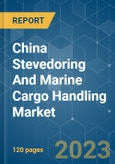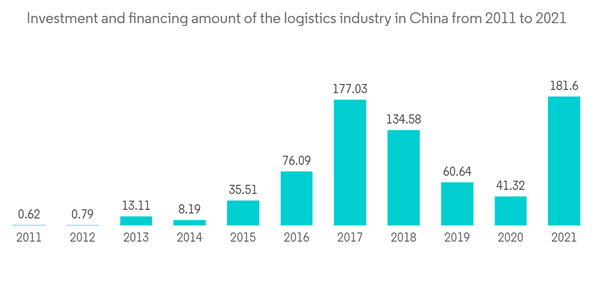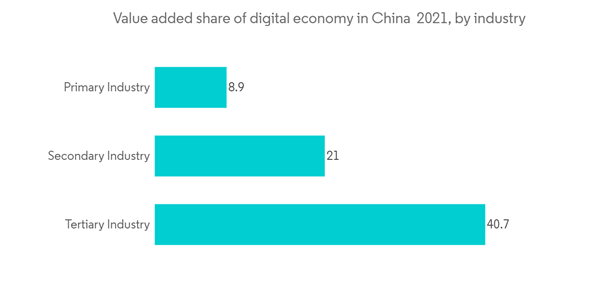Key Highlights
- The dominance of the Chinese economy has been largely fueled by their focus on export trade. China is making the best of its maritime shipping networks which have been key to its export-oriented economic development. To this end, China has invested in some of the largest and busiest, and most well-connected ports on the planet. Before the pandemic, the ports in China handled a net worth of 242 million TEUs of cargo. This number is four times greater than the container throughput of the USA. For more than 10 years, the Port of Shanghai has been ranked as the busiest container port in the world. Additionally, several other Chinese ports in Ningbo Zhoushan, Qingdao, Tianjin, Hong Kong, and Guangzhou, also make it to the list of the top 10 busiest container ports in the world.
- Throughput at Ningbo-Zhoushan Port increased by 52.4% annually to 2.35 million twenty-foot equivalent units in February, setting a record high. There are a total of 262 container shipping routes. In 2021, Shanghai Port has already committed to achieve a container throughput volume of 44 million TEUs in order to keep its title as the largest container port in the world by capacity. Thus growth in maritime trade has driven the china stevedoring and marine cargo handling market. In June 2022, Vostochnaya Stevedoring Company has commenced handling new regular container services offering direct connections to the Chinese ports of Tianjin and Taicang. The services are operated by SWIFT LINE, a marine line of SWIFT Transport Group.
- China's trade-oriented economy depends heavily on sea freight transit, which has also contributed significantly to the growth of the nation. The main growth factors for the Chinese maritime freight transportation sector are as follows: Due to its high level of overall competitiveness, China is displacing other Asian nations in terms of market share through organic growth. The fundamental engine driving the sector is China's phenomenal rate of economic growth.
- Due to the covid-19 epidemic in 2020, manufacturing has halted, trade volumes in numerous countries have fallen, and the shipping market's expansion has been significantly affected. The internal pandemic was successfully controlled in a relatively short period of time, the economy gradually recovered, industrial production quickly recovered, domestic products were supplied to the international market, and demand for export trade increased.
China Stevedoring & Marine Cargo Handling Market Trends
China’s increasing investments in the ocean freight shipping industry
The Chinese economy's dominance has been largely powered by its emphasis on export trade. China is maximizing the use of its maritime shipping networks, which have been essential to the country's export-focused economic growth. China has made investments in some of the world's busiest, biggest, and best-connected ports to achieve this goal. China's ports handled a net worth of 242 million TEUs of goods prior to the pandemic. This figure exceeds the USA's container throughput by four times. The Port of Shanghai has held the title of busiest container port in the world for more than ten years. Ningbo Zhoushan, Qingdao, Tianjin, Hong Kong, and Guangzhou are among the other Chinese ports that rank among the top ten busiest container ports in the world.In addition to improving its own port infrastructure, China controls more than 100 ports in 63 different nations. Furthermore, China is well-suited for building massive ports thanks to its 14,500 kilometres of coastline and coastal cities. China's government made over $153 billion in investments between 2012 and 2019 to build and improve its maritime shipping infrastructure. The expansion of Chinese exports and these investments led to a sharp increase in port activity. The total volume of cargo processed at the six largest Chinese ports increased from 613.3 million MT to 3.5 billion
Advancements and adoption of workflow automation
It is estimated that the market will benefit greatly from the developments in the sector of cargo handling. Because workflow automation is being used more frequently, there has been an increase in the need for cargo services, which has led to numerous attractive growth prospects for the industry over the anticipated term. A mismatch between digital and physical information results from the incapacity of current solutions to digitalize the physical process, which prevents operational efficiency from being realized. To offer potential prospects for the market's expansion, the manufacturers are actively concentrating on digitalizing solutions.Breakbulk Optimiser uses cargo booking data and vessel route information to enhance planning capabilities, and enable fact-based decisions to be made that increase operational efficiency and business performance. The cloud-based service optimises asset utilisation by unifying information and creating a more disciplined way to plan cargo carriage. Variability in the cargo planning process is eliminated by the digital algorithm, resulting in a consistent approach being taken. It also enables a better ability to react to last minute changes and no-shows because the software optimises the stowage plan.
China Stevedoring & Marine Cargo Handling Market Competitor Analysis
ASEAN Seas Line Co., Limited, China (Shenzhen) International Logistics and Supply Chain Fair (CILF), China Merchants Jinling Shipyard (Weihai) Co., Ltd, China Ocean Shipping Company, China Shipbuilding Trading Co., Ltd. (CSTC), CSSC Huangpu Wenchong Shipbuilding Co., Ltd. (HPWS), Guangzhou Shipyard International (GSI) , Qingdao Port International Limited, Shenzhen Yihaitong Global Supply Chain Management Co., Ltd, Taizhou Sanfu Ship Engineering Co., Ltd are market participants for China Stevedoring and Marine Cargo Handling. The competition amongst service providers is further heightened by the strict regulatory requirements that must be met. Businesses participate in M&A transactions to develop their product lines and expand regionally.China is one of the major participants in global marine trade. Several factors like enhanced maritime connectivity, government prioritization, development of port infrastructure, etc. have generated fantastic economic benefits for the country driving the Stevedoring and Marine Cargo Handling market in china.
Additional Benefits:
- The market estimate (ME) sheet in Excel format
- 3 months of analyst support
Table of Contents
Companies Mentioned (Partial List)
A selection of companies mentioned in this report includes, but is not limited to:
- ASEAN Seas Line Co., Limited
- China (Shenzhen) International Logistics and Supply Chain Fair (CILF)
- China Merchants Jinling Shipyard (Weihai) Co., Ltd
- China Ocean Shipping Company
- China Shipbuilding Trading Co., Ltd. (CSTC)
- CSSC Huangpu Wenchong Shipbuilding Co., Ltd. (HPWS)
- Guangzhou Shipyard International (GSI)
- Shenzhen Yihaitong Global Supply Chain Management Co., Ltd
- Taizhou Sanfu Ship Engineering Co., Ltd
- Qingdao Port International Limited










